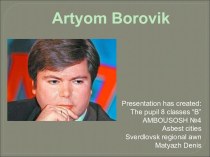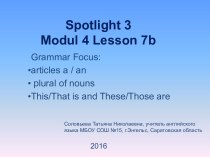- Главная
- Разное
- Бизнес и предпринимательство
- Образование
- Развлечения
- Государство
- Спорт
- Графика
- Культурология
- Еда и кулинария
- Лингвистика
- Религиоведение
- Черчение
- Физкультура
- ИЗО
- Психология
- Социология
- Английский язык
- Астрономия
- Алгебра
- Биология
- География
- Геометрия
- Детские презентации
- Информатика
- История
- Литература
- Маркетинг
- Математика
- Медицина
- Менеджмент
- Музыка
- МХК
- Немецкий язык
- ОБЖ
- Обществознание
- Окружающий мир
- Педагогика
- Русский язык
- Технология
- Физика
- Философия
- Химия
- Шаблоны, картинки для презентаций
- Экология
- Экономика
- Юриспруденция
Что такое findslide.org?
FindSlide.org - это сайт презентаций, докладов, шаблонов в формате PowerPoint.
Обратная связь
Email: Нажмите что бы посмотреть
Презентация на тему The verb: voice. The verbals
Содержание
- 2. The Category of Voice a meaningful opposition of two form classes:
- 3. The meaning of the grammatical category of
- 4. The Active Voice shows that the subject of
- 5. The subject of the sentence with the
- 6. Middle meaningThe concert began. The door opened.
- 7. Reflexive meaningJohn shaved himself. The kids washed and
- 8. Reciprocal meaningThey kissed each other. John and
- 9. Active voice in English active, passive, middle,
- 10. The Active Voice. Semantics Approach.Active voice,Passive voice,Reflexive voice Middle voice,Reciprocal voice.
- 11. We cannot accept this point of view
- 12. Grammatical category of voice in English is
- 13. The Passive voice (PV)Grammatical ways of expressing
- 14. Ways of expressing the meaning of the
- 15. Restrictions: the direct passive is not
- 16. when the object is part of a
- 17. Type 2. Indirect passive The indirect object of
- 18. Type 3. The prepositional passive The prepositional object
- 19. Type 4. The adverbial passive The adverbial
- 20. The classification of passives is a functional
- 21. The passives should be classified:ObjectiveDirectIndirectAdverbialPrepositional;Non-prepositional
- 22. Meanings of passive forms in EnglishOpinions differ
- 23. Reasons for the use of the Passive
- 24. The category of voice shows the information
- 25. In a majority of English passive sentences
- 26. Summary of VoiceThere are formal and semantic
- 27. The ways of expressing actional and statal
- 28. Summary of the grammatical categories of the
- 29. Seven morphological categories are characteristic of
- 30. NON-FINITE FORMS OF THE VERB
- 31. Non-Finite Forms vs. Finite FormsVerbals - the
- 32. Different systems of Non-Finite FormsTraditional grammar (H.Sweet,
- 33. The formal approachdenies homonymy in the language
- 34. Three non-finite forms (V.Y.Plotkin)the Infinitive, which is
- 35. The dual nature of Non-Finite Forms The verbals
- 36. The Infinitive
- 37. Functions of the Infinitive
- 38. The Gerund
- 39. Functions of the Gerund
- 40. Participle I
- 41. Functions of Participle I
- 42. Participle II
- 43. Functions of Participle II
- 44. Complex functions. Secondary predicationThe non-finite forms
- 45. Secondary predication. Transformations:I saw him crossing the
- 46. The non-finite forms belong to the paradigm
- 47. Скачать презентацию
- 48. Похожие презентации
The Category of Voice a meaningful opposition of two form classes:










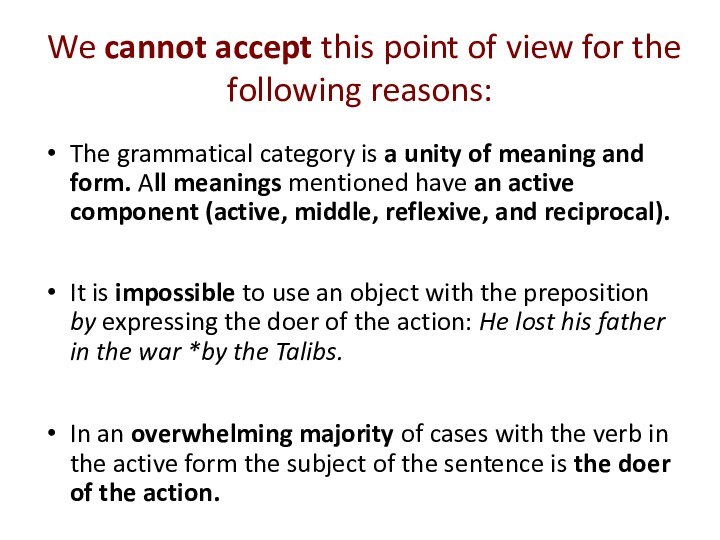





























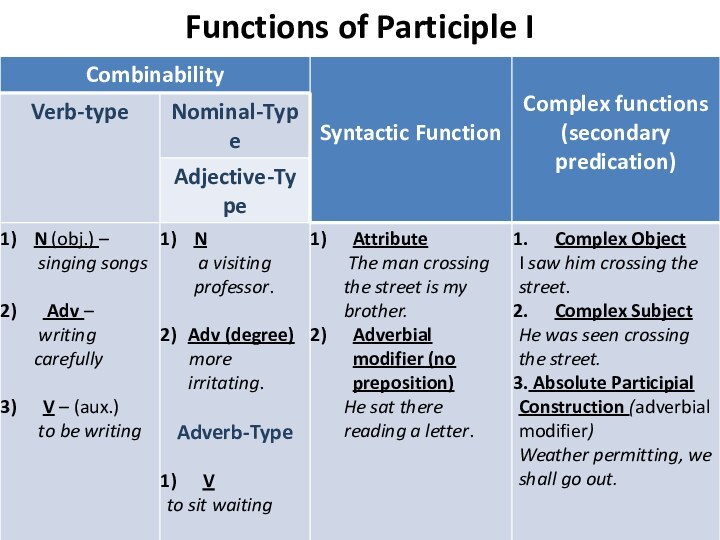




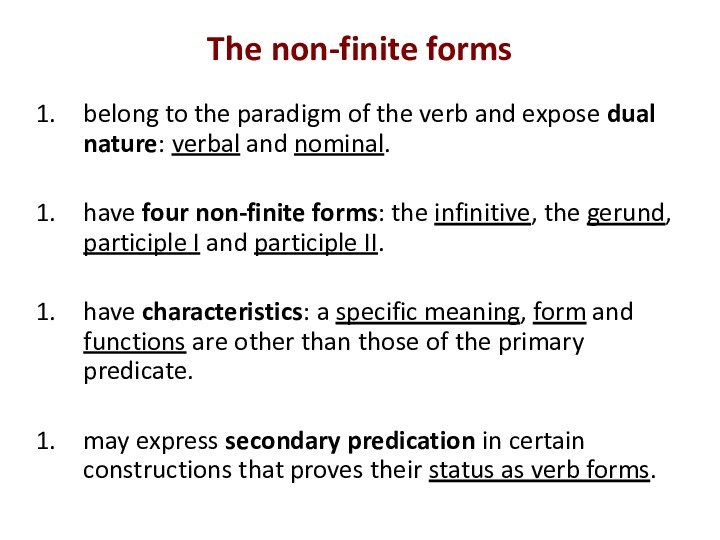

Слайд 3 The meaning of the grammatical category of voice
-
a feature of the verb indicating whether the subject
of the sentence is the agent (doer) of the action or the recipient (object) of it => the category of voice expresses the relations between the subject and the action.
Слайд 4
The Active Voice
shows that the subject of the
sentence is the agent (doer) of the action expressed
by the predicate verb, e.g.:John opened the door.
He took a pencil.
I asked a question.
Слайд 5 The subject of the sentence with the verb
in the active voice cannot actually be regarded as
the doer of the action:He lost his father in the war.
She broke her leg.
Disagreement between the grammatical form of the verb (active), and its meaning (passive).
Слайд 6
Middle meaning
The concert began.
The door opened.
The
book sells well.
The book reads like a detective
story.The verb in the active voice denotes an action, which is going on in the subject itself, but its meaning is not active either.
Слайд 7
Reflexive meaning
John shaved himself.
The kids washed and dressed.
the
subject of the sentence denotes an agent and a
recipient (doer and object) of the action at the same time.The form of the verb is active, but the meaning is active-passive.
Слайд 8
Reciprocal meaning
They kissed each other.
John and Bill
met in the street.
The agent and the recipient of
the action are different persons (referents). The form of the verb is active, but the meaning again is not only active, but passive as well, with different referents.
Слайд 9
Active voice in English
active, passive, middle, reflexive,
reciprocal.
The opposition
the passive voice
vs.
the non-passive (common)
voice
Слайд 10
The Active Voice.
Semantics Approach.
Active voice,
Passive voice,
Reflexive voice
Middle
voice,
Reciprocal voice.
Слайд 11 We cannot accept this point of view for
the following reasons:
The grammatical category is a unity of
meaning and form. All meanings mentioned have an active component (active, middle, reflexive, and reciprocal).It is impossible to use an object with the preposition by expressing the doer of the action: He lost his father in the war *by the Talibs.
In an overwhelming majority of cases with the verb in the active form the subject of the sentence is the doer of the action.
Слайд 12
Grammatical category of voice in English
is a
set of two opposed form classes:
the passive voice
& the non-passive voice. The Non-Passive (Common) voice is unmarked and extensive.
The Passive voice is marked and intensive.
Слайд 13
The Passive voice (PV)
Grammatical ways of expressing passive
meanings in English
The form of PV is marked by
the discontinuous morpheme {be= + -ed/n}. The meaning of PV shows that the grammatical subject of the sentence is the recipient (object) of the action expressed by the predicate verb:
John was punished.
Our house is being painted.
Слайд 14 Ways of expressing the meaning of the passive
voice in English
Type 1. Direct passive
The subject of the
passive construction corresponds to the direct object of the active construction: The rat was killed by the dog - The dog killed the rat.
The letter was written by John - John wrote the letter.
Слайд 15
Restrictions:
the direct passive is not used
if
the object denotes the same person as the subject,
or if the object is modified by a possessive pronoun referring to the subject:He hurt himself.
He cut his finger. (reflexive meaning).
Слайд 16 when the object is part of a set
expression:
to take courage, to keep one's word, to
lose one's patience. (phraseological character + possessive pronouns).
with to become, to have, to possess, to lack, etc.
(the lexical meaning of the verb, which includes the seme (submeaning) of the agent.
Слайд 17
Type 2. Indirect passive
The indirect object of the
active construction becomes the grammatical subject of the passive
construction:He was told an interesting story - Somebody told him an interesting story.
She was offered a new job - Somebody offered her a new job.
The passive verb is always followed by a direct object (retained object)
This construction is used only with the verb to tell and to give, to show, to offer, to promise:
He wasn't given a chance to explain.
She was promised a higher salary.
Слайд 18
Type 3. The prepositional passive
The prepositional object of
the active construction => the subject of the passive
construction:He was taken care of - Somebody took care of him.
The car was lost sight of - Somebody lost sight of the car.
The prepositional passive can be used with any verb taking a prepositional object, but it is not used with verbs taking two objects: a direct object and a prepositional object as to explain, to dedicate, etc.:
The rule was explained to us.
Not *We were explained the rule.
Слайд 19
Type 4. The adverbial passive
The adverbial passive
is used when the subject of the passive construction
corresponds to the adverbial modifier of the active construction:The bed was not slept in - Nobody slept in the bed.
The house has not been lived in for many years - Nobody has lived in the house for many years.
The use of the adverbial passive is restricted to a few examples found in fiction.
Слайд 20 The classification of passives is a functional (syntactic)
Its drawbacks:
it is inconsistent;
4 types of passive constructions are
distinguished on different principles; the base for this classification is the function of the passive subject in the corresponding active sentence;
The names "direct" and "indirect" reflect the transitive-intransitive semantics of the predicate-verb - the base for this classification is semantic.
The name "prepositional" refers to the part-of-speech combinability - the base for this classification is morphological-syntactic.
Слайд 21
The passives should be classified:
Objective
Direct
Indirect
Adverbial
Prepositional;
Non-prepositional
Слайд 22
Meanings of passive forms in English
Opinions differ on
the status of variant meanings rendered by the combination
"to be + participle II”, which has three distinct meanings, e.g.:He was awarded the top honor for distinguished achievements (the actional passive).
He was wounded (the statal passive).
He was convinced that he was right (compound nominal predicate).
Слайд 23 Reasons for the use of the Passive Voice
in English
the use of the passive voice makes it
possible to change the word order in the sentence, so as to give emphasis to new information, which is placed at the end of the sentence.the end-position (the most strongly stressed) in a sentence is connected with conveying new information :
The boy wrote a letter - The letter was written by the boy .
Слайд 24
The category of voice
shows the information structure
of the sentence as conceived by the speaker;
Is a
speaker-related category.In Russian the center of communication in similar cases is also expressed by word order, so that new information is placed at the end of the sentence: Мальчик написал письмо – Письмо написал мальчик
Слайд 25
In a majority of English passive sentences
the
agent of the action is not mentioned.
when the agent
is unknown or cannot be easily stated: The house was broken into and a few things were stolen. Or it is self-evident: He was elected MP.In the absence of the by-phrase attention is shifted to other parts which become the center of communication: The telegram was delivered on time. He was invited to dinner.
In Russian the so-called indefinite- personal sentences are found in cases of this kind: Телеграмму принесли вовремя. Его пригласили на обед.
Слайд 26
Summary of Voice
There are formal and semantic approaches
to the category of voice in English.
The grammatical
category of voice is a set of two opposed passive and non- passive (common) form-classes expressing the relation between the grammatical subject and the action. The non-passive (common) voice is unmarked both formally and semantically, it is extensive.
The passive voice is intensive. It is marked both in the form by the discontinuous morpheme (be= + ed/n} and in the meaning, which is passive.
Слайд 27 The ways of expressing actional and statal variant
meanings of the passive: direct and indirect.
The passive
voice is to change the word order, so as to give emphasis to new information, which is placed at the end of the sentence. The category of voice shows the information structure of the sentence as conceived by the speaker. It is a speaker-related category.
Слайд 28
Summary of the grammatical categories of the Verb
The
English verb has a highly developed system of grammatical
(morphosyntactic) categories:the subject-related categories: person and number;
the time-related categories: tense, aspect and phase;
the speaker-related categories: voice and mood.
Слайд 29 Seven morphological categories are characteristic of the
finite forms, the non-finite forms expose only the categories
of aspect, phase and voiceThe most important categories in expressing predicative relations are tense and mood, person and number.
The categories of aspect, phase and voice, though important in process qualification, still do it indirectly: internally (aspect, voice) and relatively (phase).
Слайд 31
Non-Finite Forms vs. Finite Forms
Verbals - the system
of the non-finite forms of the verb (the infinitive,
the gerund, participle I & participle II).This system is opposed to the system of the finite forms of the verb, the basis for the opposition being "expression - non-expression of predication".
Both systems are members of the category of finitude.
The finite forms perform the syntactic function of the predicate in the sentence,
the non-finite forms may perform any function in the sentence, except that of the primary predicate.
Слайд 32
Different systems of Non-Finite Forms
Traditional grammar (H.Sweet, A.I.Smirnitsky
and M.Y.Bloch:
the infinitive,
the gerund,
participle I,
participle
II The basis for this approach - the form, meaning and function.
All of the above forms display them in a specific way.
Слайд 33
The formal approach
denies homonymy in the language system,
there are only three non-finite forms in Modern English:
the Infinitive,
the Ing form (traditional gerund and participle I combined);
Participle (traditional participle II).
(E.Kruisinga, American descriptivists and L.S.Barchudarov).
Слайд 34
Three non-finite forms (V.Y.Plotkin)
the Infinitive, which is the
infinitive with the particle to,
"half-finitive", or "bare" infinitive,
the gerund unites both the gerund and participle I.
Participle II is on the periphery of the non-finite forms and excluded from the system.
Слайд 35
The dual nature of Non-Finite Forms
The verbals combine
the properties of:
the verb and the noun (the
infinitive and the gerund), the verb and the adjective (participles I and II).
The dual nature of the verbals is revealed in the principal spheres of the part-of-speech characterization: their meaning, form and function.
Слайд 44
Complex functions.
Secondary predication
The non-finite forms of the
verb may express secondary predication in constructions, which include:
the
Complex Object and the Complex Subject, the Complex Subject is seen as passivized Complex Object (the infinitive and both participles);
the Absolute Participial constructions (both participles) as adverbial modifiers;
the For-To- Infinitive construction and numerous gerundial constructions, which may be interpreted as complex subjects, objects, predicatives, etc.
Слайд 45
Secondary predication. Transformations:
I saw him crossing the street
–
*I saw him when he was crossing the
street. My smoking irritates her –
*It irritates her that I smoke.
Weather permitting, we shall go out –
*If weather permits we shall go out.
This ability to express secondary predication - verbal nature of all the non-finites (they belong to the paradigm of the verb).
The verb in its finite and sometimes in the non-finite form - the center of predication in the sentence.
Слайд 46
The non-finite forms
belong to the paradigm of
the verb and expose dual nature: verbal and nominal.
have four non-finite forms: the infinitive, the gerund, participle I and participle II.
have characteristics: a specific meaning, form and functions are other than those of the primary predicate.
may express secondary predication in certain constructions that proves their status as verb forms.




